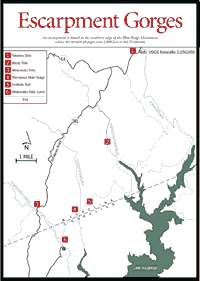 The
Escarpment Gorges
The
Escarpment Gorges  The
Escarpment Gorges
The
Escarpment Gorges At the southern edge of the Blue Ridge Mountains, the terrain suddenly plunges in a steep escarpment to the Piedmont, over 1,000 feet below. In this area rivers form deep gorges and dramatic waterfalls—some near roads and easily seen, others requiring hikes of varying lengths over rugged terrain.
[Fig. 51(3)] At 411 feet, this is one of the highest waterfalls in the eastern United States. A five-minute walk on a paved path takes visitors to an overlook with a dramatic view of the falls.
To the right, about 100 steps down the gorge, is another excellent view. This is also a good place to see the rock-loving Carolina hemlock. Along the trail, just as it descends from the overlook, large colonies of the uncommon faded trillium may be found blooming in early May. The trail descends to Whitewater River in the bottom of the gorge. There, Gleason's white trillium occurs. The rare green salamander is known to inhabit crevices below the falls.
To the left of the overlook, the visitor can follow the Foothills Trail, which passes through this point to the head of the falls about .5 mile away. Use extreme caution. Fifteen people have fallen to their deaths at this location.
 Horsepasture
River
Horsepasture
River Includes Drift Falls, Turtleback Falls, Rainbow Falls, Stairstep Falls, and Windy Falls [Fig. 51(2)]. These are a series of dramatic waterfalls along Horsepasture River, which has been designated a Wild and Scenic River. Caution: This is extremely rugged and dangerous country. Do not walk or wade close to the rim of any falls. Rainbow Falls alone has claimed a number of lives.
Another .25 mile beyond that is Rainbow Falls, which drops a stunning 150 feet over darkened, resistant Cashiers gneiss. A broad spray zone supports interesting bog and seepage-area plants. The white water against the dark rock, and the blast of spray, make's a trip to Rainbow well worth the short hike. Continue past Rainbow Falls another .5 mile to a campsite by a stream. Cross the stream at the right end of the campsite and follow the trail up the hill several yards to a path that goes down the ridge to the river. Take the path to the river, where there is another campsite. To the left of the campsite is a trail following the river downstream. Hike along it to see the aptly named Stairstep Falls. Backtrack to the main trail on the ridge and then turn right and continue walking old primitive roads.
At each possible turn, go to the right. After about 2 miles, come to the top of Windy Falls [Fig. 51(2)]. Here the Horsepasture is a roaring, windy, rushing, boulder-strewn river in a remote gorge. Some boulders at the top of the falls are the size of small cabins. Only Whitewater Falls [Fig. 51(3)] equals Windy Falls in scenic beauty. Do not try to reach the bottom of Windy Falls from the top. It is simply too treacherous. Instead, on a separate overnight trip, follow the Horsepasture River upstream from the Foothills Trail [Fig. 51(5)] to the base of the falls. It is a 3- to 4- hour hike, well worth the time. Windy Falls may also be reached from the bottom by way of a primitive road from Rosman, North Carolina, using a four-wheel-drive vehicle.
[Fig. 51(1)] This is the best place in all of Appalachia to see how vulnerably thin and shallow mountain soil is and to witness the fragility of the mountain soils and vegetation.
As recounted in The Floods of 1916 by the Southern Railway Company, on July 5 and 6, 1916, a tropical cyclone came inland from the Gulf of Mexico, reaching the western Carolinas around July 8. A second storm came in from the Atlantic, and there were tremendous rains on July 15 and 16 in the same area.
The French Broad River was at 4 feet, or flood stage, on the morning of July 15. It had come down from 8.8 feet on July 11. But with the new rains on July 15, the river rose to 13.5 feet at 8 a.m. on July 16. By 9 a.m. on the same day, the river rose to 18.6 feet. At 10 a.m. the bridge on which the height of the river was measured washed away. The crest of the flood was estimated to be 21 feet.
It was this rain that washed away the dam at Lake Toxaway in 1916 and sent waters rushing down 16 miles of the Toxaway River Gorge. The dam was not rebuilt until 1960. The force of the flood removed all vegetation from the streamside zone, leaving a remarkable scene of exposed bedrock clearly evident to the visitor today. The dam creating Lake Toxaway is just on the north side of the US 64 bridge over the Toxaway River [Fig. 51(1)].
To Whitewater Falls via the Foothills Trail [Fig. 48(8), Fig. 51(5)]. At the Sloan Bridge Picnic Area [Fig. 48(6), Fig. 50(10)], the Foothills Trail goes south toward the Fish Hatchery Road and east to Whitewater Falls, while another trail goes west to Ellicott Rock (see Ellicott Rock section).
The Foothills Trail to Whitewater Falls provides an interesting and different approach to the falls. This well-marked trail is only moderately difficult, 4.4 miles each way. Approaching the top of Whitewater Falls from upstream gives the hiker a fine view of the South Carolina Piedmont and the gorge. One could hike another .3 mile to the picnic area in the parking lot.
To Thompson River Gorge [Fig. 51(4)]. About 5 miles one-way. From the Whitewater Falls Overlook [Fig. 51(3)] (see Whitewater Falls directions), descend into the gorge to the river and walk the Foothills Trail to Thompson River Gorge and the bridge crossing it. The trail follows Whitewater River downstream for about 1.6 miles. It then crosses over ridges and follows old roads for part of the way to Thompson River.
Look for wild bergamot and several small falls. There is an especially nice slide just off the trail to the left about 10 yards before the trail makes a sharp right turn from an old road to descend into Thompson River Gorge. The rushing water, huge boulders, and steep-sided gorge provide a sense of remoteness from civilization seldom found. Some adventurous hikers may wish to rock-hop upriver to Thompson High Falls, one of the most beautiful falls in the Escarpment Gorge region. Allow 2 or more hours for this trip.
This is also one of the few areas where shortia, or oconee bells, can be seen. According to Wildflowers of the Southeastern United States by Wilbur Duncan and Leonard Foote, this flower is found in only seven counties in Georgia, South Carolina, and North Carolina.
On the other side of Whitewater River, a nature trail is marked at the point where the Foothills Trail leaves the river at 1.6 miles. Old trail books by Allen de Hart describe a cable bridge that crosses the river to the Coon Branch Natural Area. The bridge is not there now, and the river may be too high to ford. The Duke Power folder also describes a road to this area with a parking lot and access to lower Whitewater Falls [Fig. 51(6)]. This access to the lower falls, however, is blocked by the Duke Power Bad Creek Reservoir Project. One can hike to the top of the lower falls, but it is not recommended, as it requires scrambling on unmarked fishermen's paths.
One of the best ways to understand and learn about the Escarpment Gorges would be to backpack the Foothills Trail from Whitewater Falls to Toxaway River boat access or to US 178 at Laurel Valley. One could set up two cars, one at White-water Falls Picnic Area and the other at Laurel Valley. The distance would be 32.7 miles one-way along the Foothills Trail. The hiker would visit the gorges of the Whitewater River, Thompson River, Bear Camp Creek, Horsepasture River, and Toxaway River.
[Fig. 50(2)] Silver Run is one of the creeks merging into Whitewater River to create Whitewater Falls. The falls drops 30 feet into a marvelous open pool with its own beach. Sitting on a rock in this pool, one would imagine it to be very far from the road.
Map References: USGS 1:24,000 series: Cashiers–Reid; Duke Power Company Foothills Trail Brochure; Forest Service handout map with falls marked.
Read and add comments about this page